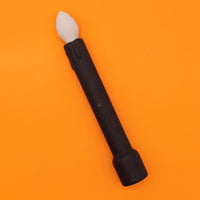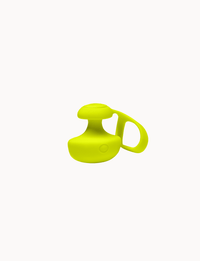Alexandra Fine, Credentialed Sexologist, M. Psych | Written by Dame
Whenever a vulva-haver begins the processes of sexual self-exploration and self-discovery, it’s probably a good bet that the first stop they make is the clitoris.
After all, it’s right there for the touching. And there’s a good reason many people call it the “sweet spot” (or the “happy button,” or the “joy buzzer,” or the “sugar plum,” or…well, you get the idea).
Clitoral stimulation is the primary source of sexual pleasure for many vulva owners, and an important – or crucial – ingredient in sexual satisfaction for many others. A good number of them, though, only learn about the clitoris and its sensitive genital neighbors by trial and error. Trial and error can be quite enjoyable, of course, but isn’t it better to have a reference guide to clitoral stimulation as well?
That’s our goal here. Let’s get started.
Anatomy of the Clitoris
Before you can understand the optimal ways to stimulate the most-accessible sex organ on a vulva-haver’s body, you first need to understand what you’re looking at (or feeling). So let’s dig into the anatomy of the clitoris.
The Clitoris is Really Huge
To begin with, lots of people don’t know an important anatomical fact about the genital region. The clitoris is much more than a small nub near the top of the vulva. Australian sexual health educator and urologist Helen O’Connell was the first to reveal the truth to the world: the clitoris is really a large, bulb-shaped sex organ that extends well into the body; about 90% of it is “internal” rather than “external.” What most people call the clitoris is simply the small part of the organ that you can see or touch. (The proper name for the “pleasure button” is glans clitoris, by the way.)
The full clitoris is shaped something like a wishbone, if the wishbone had extra legs. It extends nearly five inches into the body and almost all of the way to the cervix, making it almost as long as the average penis. The internal clitoris has a number of parts, three of which contain the organ’s erectile tissue that swells during sexual arousal: a short body (known as the corpora cavernosa and sometimes called the shaft), the crura (“legs” that extend out from the corpora), and two vestibular bulbs which run close to the vaginal wall.
There are about 8,000 nerve endings in the glans clitoris, which is why it’s so sensitive and able to provide such sexual pleasure. But the internal clitoris is loaded with nerves as well, and it engorges with blood and swells during arousal – so there’s a great amount of pleasure hiding inside the body.
There are several ways you can discover the internal clitoris. If you use your hand to press down on the vulva that will stimulate the vestibular bulbs, and if you massage the area just above the pubic bone, that will hit most of the internal clitoral structure. Deliberate, slow vaginal penetration may also create pleasure in nearby areas of the clitoris.
The best choice, though, is one you’ve certainly heard of, or tried – you just didn’t know that the clitoris was involved. Most experts (with the exception of a small group of researchers led by Vincenzo Puppo) now believe that the famed G-spot “female orgasm” (and possibly “female ejaculation”) are really produced by contacting the area of the vaginal wall that’s closest to the vestibular bulbs of the clitoris. In other words, a G-spot vaginal orgasm is just a different type of clitoral orgasm.
It’s difficult for most people to visualize the internal clitoris, but the external glans clitoris – and the parts of the vulva that protect it – aren’t hidden or mysterious.
The External Clitoris – and Its Friends
The genital area that you can see and touch is known as the vulva. (Obviously, we’re discussing vulva-havers and not penis-havers here.) The vaginal opening and the opening of the urethra are considered part of the vulva, but for the purposes of discussing clitoral stimulation, we’re just concerned with the glans clitoris and the external genital organs that surround it.
Those external organs have three purposes: making sexual activity more comfortable, protecting the internal genitalia, and – the big one – providing sexual enjoyment. Many people who don’t have their own vulvas may not even realize that the “body parts” that surround the glans are important, too – but they are.
- Labia: The inner lips (labia minora) and outer lips (labia majora) are the concentric folds of skin that meet, at their bottoms, just above the vaginal opening. The labia’s most important function is protecting the even more-sensitive clitoral glans and vaginal/urethral openings, but that’s not all they do. The outer lips contain glands that secrete lubrication during arousal and sexual stimulation; the inner lips swell and become sensitive during sexual activity, providing a way to indirectly stimulate the glans.
- Clitoral Hood: The hood (prepuce) is a flap of skin that covers the glans clitoris to protect it from irritation and “undesired” stimulation. It’s somewhat similar to the foreskin that protects the head of the penis. During arousal, the glans swells and pushes aside the clitoral hood to allow easy access; that’s often described as the hood “retracting.”
- Mons Pubis: The pubic mound is fatty tissue that covers the public bone. Many vulva-havers find it to be sensitive and another erogenous zone worth targeting for stimulation. It also contains glands that release pheromones designed to create sexual attraction.
That information was all pretty dry (no pun intended). Admittedly, it’s more enjoyable to explore the vulva with fingers or a vibrator during masturbation than it is to read about it.
It’s time to talk about that clitoral stimulation in more detail.
Why the Clitoris is So Important for Sexual Satisfaction
Orgasms can be created through stimulation of many erogenous zones, but the three most commonly discussed (and enjoyed) are the clitoris, the vagina and the anus.
That’s not always as easy as it may sound.
Studies and surveys continually show that fewer than 20% of vulva-havers are able to climax solely from vaginal penetration. Well over two-thirds say that they’re unable to achieve orgasm during penetration without simultaneous clitoral stimulation, and another one-third say that their vaginal climaxes are more satisfying when clitoral play is also involved. Research also indicates that those who prefer clitoral orgasms feel that they have more control over their sex life.
Not everyone is the same, of course. If you ask cis women whether they prefer vaginal or clitoral climaxes and which feels “better,” you’ll get widely differing answers. But it’s fairly safe to say that clitoral stimulation is the most common way that vulva owners experience orgasm.
Here’s how to get the greatest possible satisfaction from clitoral play.
The Clitoral Stimulation Playbook
These should be considered suggestions rather than instructions, but they’re all designed to let you (or a partner) get to know your clitoris more intimately – which will lead to a more enjoyable experience. Believe it or not, these are pretty much the same steps that sex therapists suggest for their patients, without the hefty bill that usually accompanies therapy sessions.
And always remember: sex isn’t like playing the piano. The practice can be just as much fun as the performance.
(One note: these tips are written with solo play in mind, but most will work just as well if exploring with a partner.)
Get Comfortable
You’re not going to enjoy your exploration and clitoral play if you’re scrunched up in a chair or hiding from the rest of the family in the bathroom. Find a time and place where you can undress, relax, and have the full range of motion needed to spread your legs or try different positions. If music, candles or getting warmed up with erotica normally put you in the right mood and heighten your sexual response, go for it.
Exploring with a partner? Mutual touching or foreplay can heighten arousal and stimulate lubrication before getting down to the business at hand. (But think of it as fun, not business!)
Don’t Make Your Body Do All the Work
Even if you naturally get wet when you’re excited, don’t count on that to be enough. It might be, but you should always have some lube on hand. Look for water-based products (they’re easy to find at Dame Products or on Amazon), because they won’t damage sex toys.
Look Before You Touch
We’ve discussed the anatomy of the clitoral area, so you’re now familiar with the terminology. But can you associate the names with the actual body parts? Before plunging in, take a brief inventory (using a mirror may help) so you can distinguish the glans clitoris from the labia and the clitoral hood. Each feels different when stimulated, so knowing exactly what you’re touching will make it easy to find the area you’re looking for once it’s time to play.
Time to Get Hands On
Don’t worry, the wait was worth it. Slowly begin your exploration, running your fingers across the outer and inner lips, the clitoral hood, the clitoral mound, and finally the clitoris itself. (We’ll use the term clitoris from this point forward, as most people do, to describe the glans clitoris.)
Be sure to notice the different sensations you feel when touching and gently rubbing each part of the genitals. Don’t shoot for excitement or climax just yet – this is still a familiarization and exploration mission. It’s also best to hold off on the vibrator for now, since you’ll get the best feel by using your fingers. There’s plenty of time for sex toys once you’re intimately familiar with the clitoral area.
Pay particular attention to how sensitive each area is. Some people find that direct clitoral stimulation is too intense, and prefer to rub or massage the labia, hood or clitoral mound instead. And if that’s still too much to take, you can use your underwear or a pillow as a buffer. As we keep saying, everyone’s different, and there’s no “right” or “wrong” when it comes to clitoral sensitivity.
Once you’re comfortable with the geography and the sensations, you’re ready to take the next step.
Now, the Fun Part
Assuming that your clitoris isn’t too sensitive for direct stimulation, it’s time to experiment with different motions and pressures.
Any type of motion you can think of is fair game. Use one or two fingers (yes, the thumb counts) to massage, stroke, circle, press, tap, knead, pinch or gently pull the clitoris, to discover which motions provide the most satisfying feelings. Try the same thing for the labia and clitoral hood as well, to discover what feels best. Many people find that alternating some or all of the possible motions (or locations) can keep excitement levels high, although one or two of them will usually end up being the go-to choices when orgasm is close.
Varying the pressure can also create a roller-coaster of sensations, although clitoral sensitivity may limit the amount of pressure you can comfortably enjoy. The clitoral hood, if it doesn’t retract, may actually be responsible for a lack of sensitivity; you can always use a finger to move it up and out of the way if you want things to get more intense.
Don’t forget about toys and partners once you feel that you’re ready for them. A clitoral vibrator like the Kip or the Fin allows you to pinpoint areas of the clitoris you want to stimulate, while a bigger vibe will contact larger areas of the vulva. A partner’s fingers will come from a different angle, and their tongue will provide very different sensations. Both are worth trying and enjoying.
And if you combine clitoral and vaginal stimulation – the way that the majority of vulva-owners realize maximum satisfaction – changing sex positions can also change the sensations that clitoral stimulation will provide.
Above all, take your time! The clitoris isn’t a magic orgasm button, so if you’re shooting for a climax clitoral stimulation may require more than a few minutes to pay off. Thankfully, once you’ve become intimately familiar with your erogenous zones and the pleasure they can provide, the trip can be just as enjoyable as reaching the destination.


















































